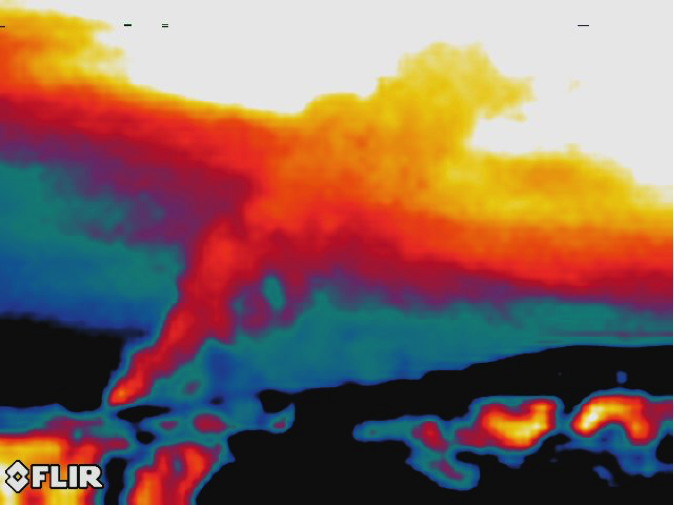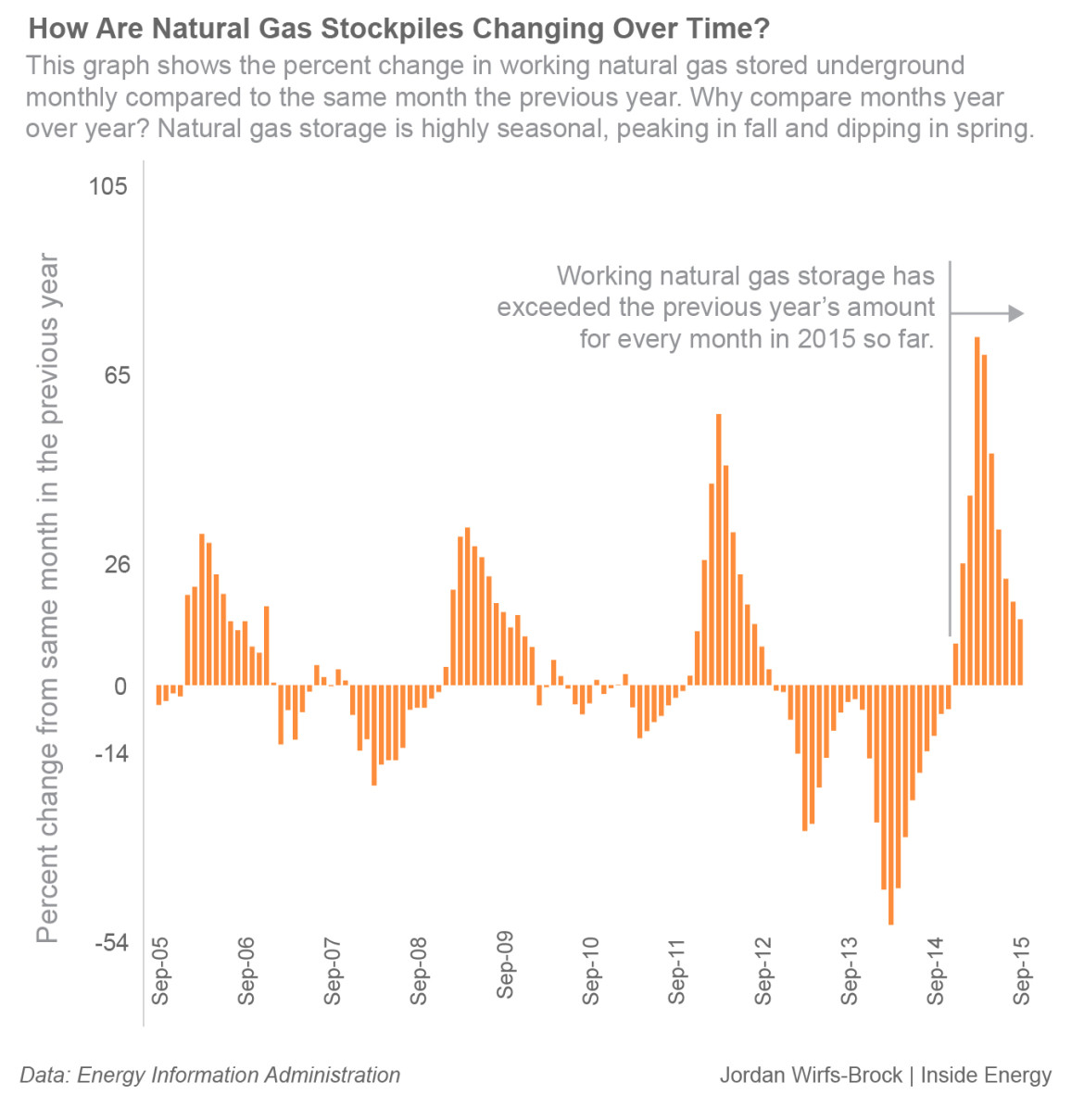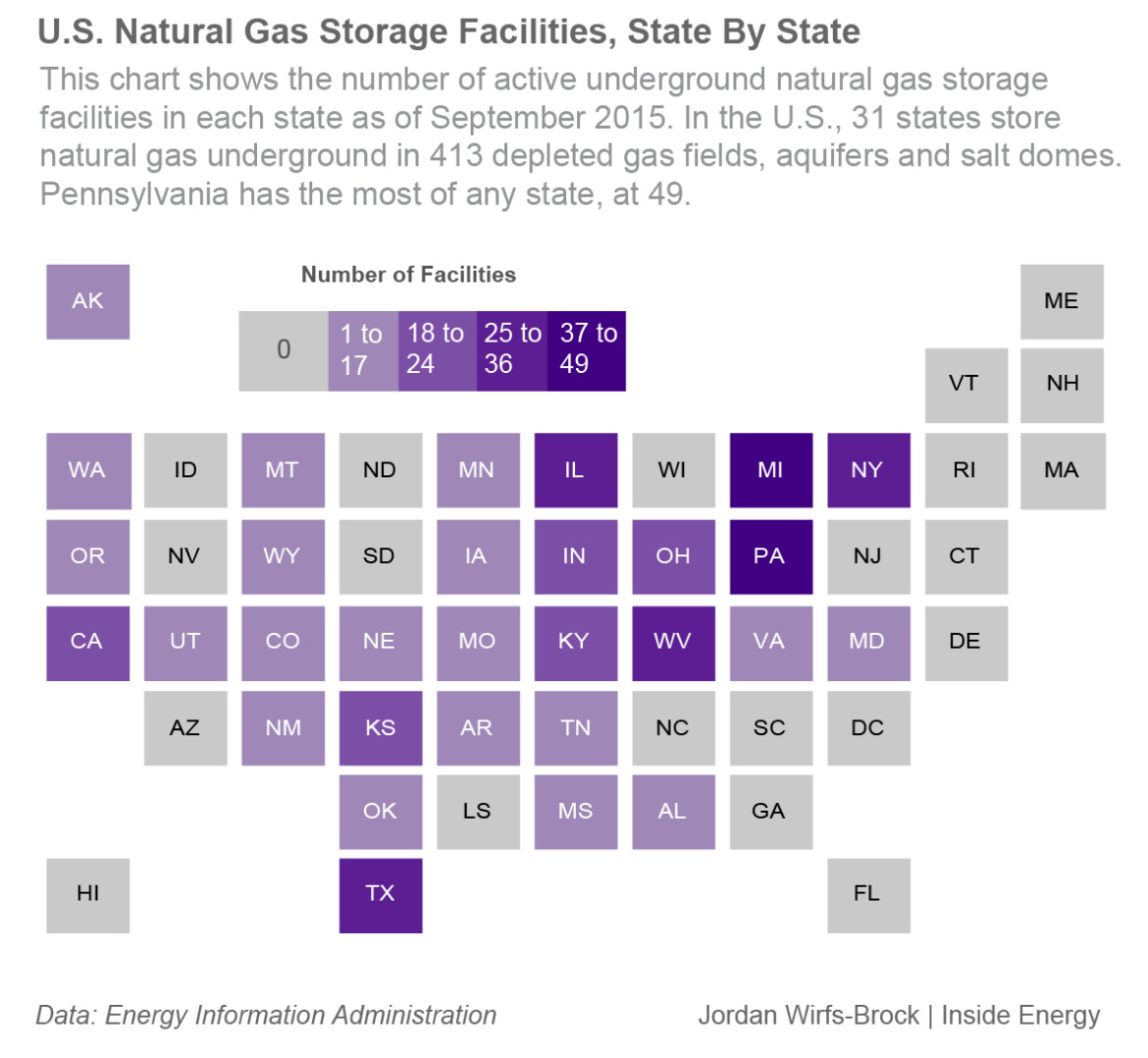
Environmental Defense Fund
Infrared images like this one taken Dec. 9, are making it possible to see the massive escape of methane and other gases from the Aliso Canyon Gas Storage Field in Los Angeles County.
A giant stream of potent climate-warming gas – methane – is blowing hundreds of feet into the air in Los Angeles County for the seventh week. The release cancels out hundreds of smaller efforts over more than a decade to clamp down on escapes of the gas, a priority because in the short term, methane is a far more powerful climate-warming gas than carbon dioxide.
Pilots flying low have been told by the FAA to stay clear of the plume for fear of ignition. More than 1,800 families have sought relocation due to the vapors. Southern California Gas Co. officials say it will be months before it can be stopped.
The mainly methane gas is pouring out of the ground near a damaged well used to inject gas into an old sandstone oil field for storage.
“I think what we are seeing is probably one of the single largest releases of methane in California history,” said Tim O’Connor, who used to inspect major facilities like refineries for the Bay Area Air Quality Management District and works for the Environmental Defense Fund.
“People I speak with who are experts in the field say this is biggest, most complex leak that they have ever seen.”
Authorities estimate the rupture in the well, perhaps more than a mile deep, is sending 100,000 pounds of methane into the air per hour. Methane traps heat more powerfully than carbon dioxide during its approximately 20-year stay in the atmosphere, giving it an outsize role in rising sea levels and disrupted weather.
The Aliso Canyon Gas Storage Field, covered with wells, is owned by Southern California Gas Co., a subsidiary of Sempra Energy, based in San Diego.
“We have never had an escape this large,” said Gillian Wright, Vice President for Customer Services for Southern California Gas. “I have to really emphasize this is an extremely rare event. The extent and the difficulty of resolving this leak are highly, highly unusual.”
All the methods the company has tried so far to kill the well have failed. Now experts who fought the Kuwaiti oil field fires a quarter century ago have joined the effort. The safety of the some 100 workers on the site is also a concern. Wright said that is why on some days, the company cannot perform certain work. If the wind is blowing methane over certain equipment, crews cannot start that equipment, she said.
As of the weekend, 1,800 families, ill or frightened by sulfurous gas drifting down from the site, have been relocated from Porter Ranch, paid for by the gas company. An additional 1,433 families have asked to be moved, said Melissa Bailey, a company spokeswoman.
Among those who have left are George Chang and Susan Gorman-Chang. Gorman-Chang said the first time she felt the full impact of the unfolding events was midway through her habitual five-mile run, when she felt the strong smell of gas, or to be precise, an additive intended to give an odor to the otherwise odorless gas. With no alternative, she ran through it until she reached home. “I was really, really dizzy the next morning.” she said.
Then on Sunday, Nov. 22, before church, she said, she opened the back door to let the dog out and was sickened by gas. Now the Changs reside in an extended stay hotel with a mini kitchen, but no oven. Some of her fellow refugee neighbors are considering getting air filters, but she has mixed feelings.
“Are we in one of those sci-fi movies where you run from your car to your home and you can never go outside?” she asked. “How is that OK? What kind of a world have we created up there?”
Several lawsuits have been filed. Marquee environmental litigators are partnering in the effort. They liken the release to the 2010 Deepwater Horizon well blowout in the Gulf of Mexico.
At a gathering Dec. 9 organized by lawyers, they struck at residents’ deepest fears. “Everyone here has suffered a huge property loss,” said trial attorney R. Rex Parris. “The secret is out. There is a bomb underneath you.” He invited those in attendance to sign up to be represented by counsel.
He also announced he was adding co-counsel, including lawyers who represented plaintiffs in the BP Deepwater Horizon case and Robert F. Kennedy Jr., who in his remarks called the California Division of Oil, Gas and Geothermal Resources a “sock puppet.”
Steve Bohlen, the scientist who heads up the agency, said making sure that Southern California Gas seals the well quickly and appropriately has “consumed the attention” of his division. “We have directed them to build a relief well. We have directed them to prepare a second relief well,” he said.
But the oil and gas chief said if the state is too directive, it risks assuming liability for the consequences.
“This is Southern California Gas’ problem to fix,”Bohlen stressed.

Some researchers say not enough attention has been paid to to underground gas storage fields, a mainstay of the natural gas distribution system, if little known to the average gas customer. In the western United States these storage areas often consist of older oil fields where the original production wells have been converted to injection wells for gas. Sometimes new injection wells are drilled. The natural gas is gathered from remote areas, in this case Texas, New Mexico, the Rocky Mountains or Canada. Pipelines bring it to places like Aliso Canyon where it is compressed and pushed into formations until it is withdrawn when southern Californians fire up their heaters in winter.

Aliso Canyon is the largest such facility on the West Coast, according to Southern California Gas Co.’s Wright. Aliso Canyon can hold 86 billion cubic feet of gas. The company is withdrawing gas as quickly as possible to diminish the pressure that is forcing the gas to escape. “It is at the heart of our system in terms of supplying and managing demand,” Wright said.
Officials who have focused on reducing methane emissions because of the impact on Earth’s atmosphere have paid more attention to strengthening regulations on pipelines and wells and the other places from which methane escapes.
O’Connor of Environmental Defense Fund said the gas gushing from Aliso Canyon is roughly equal to that emitted by six coal-fired power plants or 7 million extra cars. “I think we have found a regulatory gap,” he said.
Officials at both the federal and state level are formulating new rules for reducing emissions of methane. Underground natural gas storage is now likely to get more scrutiny.
This story comes to us from inewsource, an independent investigative news service.
What’s Next:
- Check out earlier stories on this issue by Ingrid Lobet. This one has astonishing video of the methane leak, and this one explains that the leak will make a significant impact on California’s emissions.








